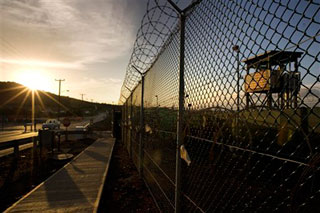We like to think of ourselves as a great nation, a compassionate country that puts human rights at the forefront of everything we do. Then, how in the world can we defend what the United States continues to do at Guantanamo Bay, Cuba?
Videos by Rare
The American prison for enemy combatants was established in January 2002 by then-President George W. Bush as a place to park detainees that were connected with the radical Muslim movement waging war against America. A total of 779 prisoners have been sent to Gitmo, and today — 11 years later — we still hold 166 of them. No charges have been filed against most of these men. Years ago about half of them were cleared for return to their home countries (or a willing third-party country), yet they still sit at Gitmo.
President Barak Obama made an election promise to close Guantanamo Bay back in 2007, but he was blocked by Congress, which passed restrictions on what could be done to transfer the prisoners. In April, the president promised again to pressure Congress, saying, “The idea that we would still maintain forever a group of individuals who have not been tried — that is contrary to who we are, it is contrary to our interests, and it needs to stop.” The reality, however, is that it is unlikely our fractious Congress will do anything.
So, the 166 men at Gitmo remain in a protracted state of imprisoned limbo, and more than half of them have been on a prolonged hunger strike. Over the years, their health has become so perilous at times that the U.S. military made the decision to strap them down in chairs and force-feed them though tubes inserted in their noses.
What have we wrought? Are human-rights activists correct when they say America’s policies have left the detainees so completely hopeless and suicidal that they are driven to starve themselves to death? Or are U.S. military officials right when they say the prisoners denying themselves food is just another weapon in their arsenal to paint America as the Great Satan?
I don’t know the answer. Likely it is a combination of the two. But the U.S. practice of forcible feeding has been roundly condemned by the World Medical Association, the United Nations High Commissioner for Human Rights and the American Medical Association, which declared the forced feeding violates “core ethical values of the medical profession.”
Two Democratic senators — Dianne Feinstein of California and Richard Durbin of Illinois — have written to the president, asking him to order an immediate stop to the “painful, humiliating and degrading process.” In a most unusual step, a federal court judge named Gladys Kessler, ruling on a Gitmo prisoner’s request for an injunction against his forced-feeding, made a direct appeal to the president to take action on the issue that has been going on for so long.
I wonder if the average American knows about the detainees’ individual stories and what has happened to them since they’ve been in U.S. custody. Their cases are shocking.
The longest continuous hunger-striker appears to Abdul Rahman Shalabi, 35, a Saudi man who reportedly has been largely tube-fed since 2005. Mohammed Bawazir, 33, a Yemeni, had a lawyer who went to U.S. federal court to try to stop the forced-feeding of his client and lost. That was back in 2006. Another detainee, Tariq Ba Awdah, originally from Yemen, has apparently been on an uninterrupted hunger strike since February 2007. According to the Miami Herald, the 35-year-old wrote to his lawyer, “I haven’t tasted food for over six years.” Today, a total of 45 Gitmo prisoners are being given nourishment through forcibly inserted gastric tubes.
Think of that in real-life terms. Every single day American soldiers are under orders to scoop up these malnourished and skeletal prisoners, strap them down and insert tubes into their noses so nutrients can be administered. I am positive that not one of those soldiers looks forward to that duty.
There are recent reports that some of the other hunger-strikers have begun to eat again, but military doctors told The New York Times they must be on hand to guard against “refeeding syndrome,” which can be fatal when “undernourished people suddenly consume food.”
Again, what have we wrought? Are you sure that America — the great and benevolent super power that we think we are — couldn’t have come up with a better solution for handling these prisoners? There is a part of me that is ashamed that it has come to this.
No right-thinking person advocates opening up the gates of Gitmo and simply waving goodbye to these 166 prisoners. Some likely still pose a threat to the United States. But let’s redouble our efforts to do the right thing. A good first step would be to seriously concentrate on getting those low-risk prisoners who have already been cleared for release out of Gitmo.
Let’s face it; at this point Gitmo has imprisoned all of us — imprisoned us in our own braggadocio that we are a country based on human rights. Guantanamo Bay prison is living proof that we are not, and what has already happened there will be a historic stain on our human rights record.
Congress needs to get off its duff and agree to lift the restrictions that keep the cleared prisoners behind bars. They need to agree to transfer the high-risk group to the United States so we can close that hellhole called Gitmo. Giving speeches about the issue isn’t action, and it won’t solve this humiliating human rights problem. The president needs to step up and truly lead — pound the table if he has to. The world is watching.
© CREATORS.COM



